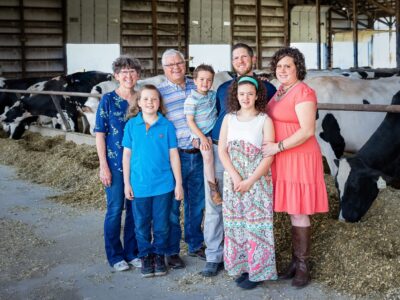EPA to Inspect More Dairy Farms: What You Need to Know
11-06-2014 in Dairy
We have learned EPA will be taking a harder look at Iowa dairy farms. I sat down with the Coalition to Support Iowa’s Farmers Sr. Field Coordinator Kent Mowrer to find out what EPA will be looking for during these inspections and how dairy farmers can prepare.
Q1: What will trigger an inspection?
A: There are three main factors EPA or DNR will look at to determine if your farm will receive an on-site inspection: 1) if you are over 300 animal units; 2) your farms proximity to water; and 3) discharge potential from an open lot or manure application field.
Q2: What are animal units? And what is the proper way to count animals?
A: There are two animal unit conversion factors used for dairy farms. Immature dairy cattle are considered 1.0 animal units. Mature dairy cattle (cows that are sexually mature and can breed) are considered 1.4 animal units. Once a calf is removed from the cow, the calf becomes its own animal unit and must be counted.
All animals on the farm need to be counted to determine your total animal unit capacity. If the farm is over 300 animal units, it falls into the medium-sized category and may be eligible for an inspection.
Q3: What does proximity to water mean? What distance will trigger an inspection?
A: Open lots or feed storage areas that are within a ¼ mile of a watercourse will likely receive an onsite inspection, particularly if the lot or feed storage drains toward that water. Impaired watersheds may be more closely scrutinized and impacts from animal feeding operations may be evaluated more than a ¼ mile away.
Q4: Tell me more about discharge potential. What do you mean by that?
A: Each farm should evaluate their facilities to determine if runoff from open lots, feed storage, manure storage areas and compost piles is making its way to nearby watercourses. If so, controls need to be installed to discontinue the discharge. CSIF offers no-cost, confidential on-farm assessments to help farmers evaluate their current situation and can make recommendations on options to control runoff.
Q5: You mentioned discharge potential from manure application fields. Why does it matter?
A: Fish kills have occurred because of improper timing of manure application. If you’re applying manure next to streams or ditches, a good practice is to incorporate the manure within 24 hours.
Iowa law requires that all manure be applied in a way that will not negatively impact water quality. For more information on the manure application rules, check out this factsheet.
Q6: If a dairy farmer wants to know how the rules apply to their farm or have concerns about an inspection, who can they contact for confidential assistance?
A: The Coalition to Support Iowa’s Farmers is a great resource for dairy farmers. All of our services are available at no-cost and everything is completely confidential. So a farmer can give us a call, ask questions specifically about their situation or have us come to the farm, all without worrying about DNR or EPA finding out.
The rules and regulations today are complex. We’re here to help dairy farmers, and all Iowa livestock farmers, navigate the rules and regulations and help them continue their family farm legacy into future generations.
(The funding for the Coalition comes from Iowa’s ag commodity groups, including the Midwest Dairy Association.)
Mowrer serves as the Sr. Field Coordinator for the Coalition to Support Iowa’s Farmers.
Recommended News

CSIF Helps Farmers Tell Ag’s Story
New Day Dairy near Clarksville in Butler County is unique in many ways. In addition to its state-of-the-art robotic milking operation, it houses a guest barn designed to give...
Read More
Iowa Livestock Insider // Winter 2021
Read More
Report Suspicious Vehicles Near Livestock + Poultry Farms
Recently, there have been reports of suspicious vehicles parked along the road near livestock + poultry farms throughout the Midwest, including Iowa. In some instances, people are just taking photos...
Read More